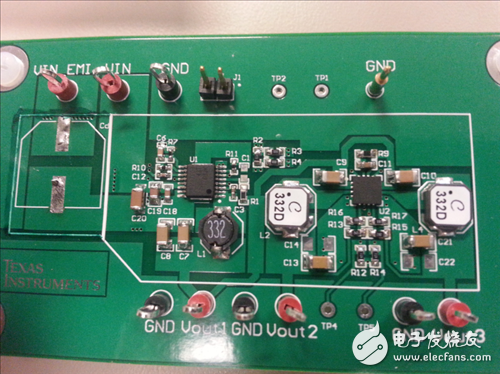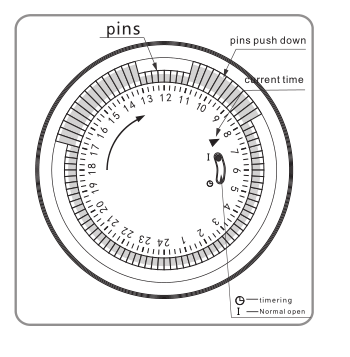Industrial power supply design engineers face numerous power supply challenges; one of the main challenges is the large variation in the input voltage range. There are many reasons for this, including design support for long distances. For example, a factory has a main voltage rail that travels throughout the building. These long voltage rails create a voltage drop due to impedance, as well as induced voltage and noise caused by devices connected to different locations of the power supply, or heavy loads caused by large inductive and capacitive components. Figure 1. Wide Input Voltage (Vin) Low Noise 3-Output Buck Converter Reference Design The reference design in Figure 1 is a single-input buck converter with three low-noise outputs. This module uses the LM43603, a SIMPLE SWITCHER® synchronous step-down DC/DC converter that can drive up to 3A of load current with input voltages ranging from 7V to 36V. The LM43603's 5V output can drive the LM26420 DC/DC regulator (see Figure 2), further reducing the output voltage to 1.8V to 2.5V, each capable of driving 1A of load current. This power supply is suitable for applications that require multiple outputs from a single input DC voltage. It provides excellent regulation over an input voltage range of 7V to 36V. Combining a fully synchronous switching regulator with good place-and-route technology makes it possible to develop a compact solution like this. The reason why low-noise solutions are so important is that users don't want to bring the initial problems of noisy power supplies to subsequent designs. If the power supply can operate over a wide voltage range, it enables industrial engineers to overcome the problem of variable voltage input range while enabling them to have multiple variations in different voltage ranges (such as 12VIN or 24VIN). “Cut and paste†on the back panel. This makes design simpler, speeds up overall time to market, and lowers costs. The low noise solution extends the number of designs connected to the main backplane without adding additional design challenges. Figure 2. LM26420 Dual DC/DC Converter references: Get more information on all TI DC/DC power products. In your next power supply design, consider using the LM26420 and LM43603. Download the wide VIN low noise 3-output buck converter reference design. Learn more about TI industrial applications. 24 hours mechanical Timer
setting at any time
Instructions:
Specifications:
Caution:
6.T his item is only for indoor use.
Mechanical Timer, mechanical timer socket, 24hr mechanical timer, mechanical timer plug, mechanical timer adaptor NINGBO COWELL ELECTRONICS & TECHNOLOGY CO., LTD , https://www.cowellsocket.com

Instant indicator
Min.setting time:15 minutes. Max.setting timer:24 hours
With hand switch,can be switched to operating and

1. Set program: 1 pin is equivalent to 15 minutes. Determine desired start time and push down pins until desired
off time.
For instance, if you want electrical devices to work from 8:00am to 11:00am and from 13:00pm to 17:00pm, you
just need to put down allthe pins between the three period time.
2. Set the current time: Turning the dial clockwise until the arrow pointing to
current time.
For example,if now it is 8:00 am, please turn the dial and make sure the
arrow point to 8. (See the picture.)
3. Plug the electrical device directly into the timer. Make sure the electrical
device is power-on.
4. Plug the timer into electrical outlet and the electrical device will be work
according to the setting program.
Note: = Normal Ope n = Timing
Make sure the switch on the Timing position. If it
is on the [Normal Open" mode, the electrical device is
always power-on and the timer function no work.
Rated Voltage, Current and Power
As shown on the label
Time Setting Range
15minutes24hours
Working Temperature
-10℃?+55℃
Operation
Clockwise
Insulation Resistance
>100M
Inherent Loss
≤1W
Application:
1. To enable high-power electric appliances to run automatically at off-peak time if there is different electricity
price according to different periods of time in some areas.
2. To use for electric appliances which need time control, such as water heaters, air conditioners, drinking
fountains, rice cookers, advertising lights and so on.
3. To control the charging time. For example, battery of electric bikes or mobile phones, storage batteries, etc.
4. Occasions which need switch on/off frequently, like interval spray irrigation for flowersand lawn, cyclical
adding oxygen to fish jar, fountains and so on.
5. Home safety precautions and lighting.
1.D o not exceed the maximum ratings of the timer.
2.M ust reset the current time after power failure.
3.D o not plug the timer directly into the working electrical appliances.
4.U nless changing the setting, keep the program same every day.
5.D o not disassemble timer by yourself. Professionals service are needed for maintenance.